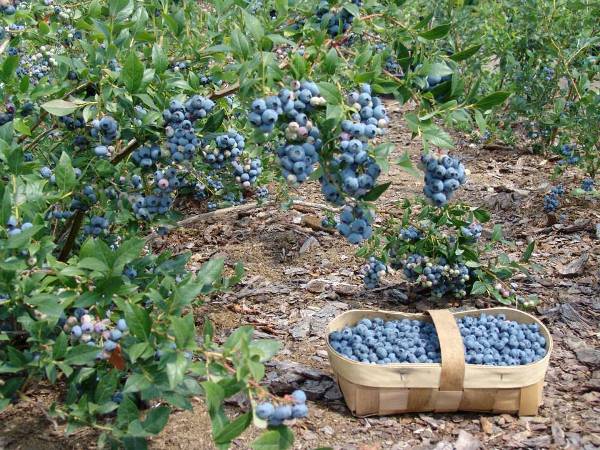Blueberries are called “black pearls”, “the berries of millionaires”, but they are also considered “intellectual berries”. Garden blueberries are a rather demanding culture, but you can also find a common language with them.. The methods of cultivation to which we are used to are absolutely not applicable: manure, ash, and occasionally water. This shrub will not grow well without a sour, loose and moist substrate.
Table of contents
What is blueberries
Blueberries are a shrub whose height is usually about 1 meter. It has curved, smooth branches of gray shade. The leaves reach a length of 3 cm. The flowers are quite small, pentadent white or pink. The berries themselves are blue and gray in bloom. The fruits of the shrub are edible, very juicy and sweet.
The Differences Between Blueberries and Blueberries
Blueberries and blueberries belong to the same family.but there are some differences between them.

- The blueberry bush is usually lower than the blueberry bush.. Also, blueberries are characterized by soft stems, and blueberries are harder. The color of the blueberry stalks is lighter.
- Another difference is how one shrub grows. Blueberry bush grows very close to the ground.practically creeps. Blueberry bush grows vertically.
- Blueberries can grow almost anywhere.including soils that are not very rich in useful properties at home. And blueberries grow mainly in pine forests.
- Berry Juice Blueberry has a rather dark shade, and from the berries of blueberry juice will turn out colorless.
- The most difficult to distinguish the fruits of these shrubs by external and taste. Externally, blueberries have a much darker color of the berries and white bloom on them. To taste more saturated. And the fruits of blueberry are larger in size, oblong, and they are also much lighter than blueberries. To taste, blueberries are more neutral and sour.
- Another difference is berry color. Blueberry has a deep blue tint, while blueberry has a greenish tint.
These two shrubs - blueberries and blueberries - are very similar to each other, but still they can be distinguished from each other.
Where does blueberry grow and when should you pick fruit?
Blueberries grow in completely different areas. This shrub is so unpretentious that it can bear fruit even on poor soils. Common blueberries are most common in the territories of Siberia, the Urals, as well as in the forests of the western part of Russia. In the marshes, in the shade, blueberries ripen the largest.
Blueberries ripen in mid-summer and can be harvested until the end of August - beginning of September. Some people use a special machine to collect blueberries. This is not entirely correct, because in this way it is possible to damage the fruits during their collection, as well as the root system. It is better to pick the berries by hand.
Is it possible to grow blueberries at their summer cottage?
Plant blueberries at their summer cottage. To date, a large number of garden blueberry varieties are known, the most popular are: Patriot, Bluray, Duke, North Country and others. But, if you do not take into account a number of features of cultivation of this shrub, then an attempt to get a good harvest may not be crowned with success.
Planting a garden blueberry
When planting blueberries at their summer cottage, it is necessary to pay special attention to some growing features this shrub.
Selection of seedlings
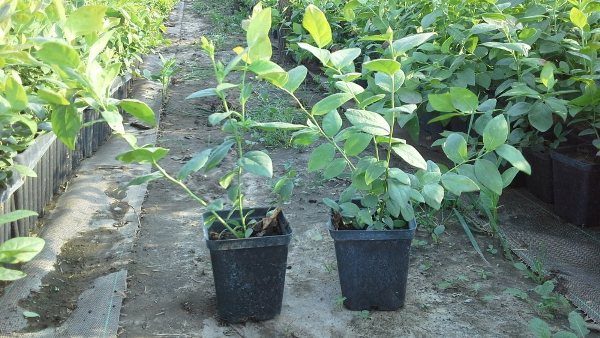
It is very important that the seedlings are healthy, and their leaves are green and without spots. If the purchase of seedlings is carried out in spring or late autumn, when the foliage has already fallen and there is no way to accurately determine whether the leaves are healthy, then pay special attention to the bark. On the branches, it should be without characteristic patches of burgundy or brown color, which indicates any diseases of the plant. But there are situations when it is not possible to look at the condition of the seedlings, for example, if they were ordered by mail. In the event that any defects were eventually found, you can simply cut the diseased branches to healthy tissue. You can also grow seedlings on your own from blueberry seed.
Choosing a place to land at the cottage
Blueberries love the sun and do not like the wind. The place should be open and sunny. To protect against the wind on the north side, you can use a fence, an agrofabric screen or a hedge. Tall fence 1m breaks the wind on 10 mthat is, behind such a fence there will not be a strong wind that manages to erase the bark on the branches, where infection then easily gets. Ripening berries from the wind lose their delicious blue bloom and poorly stored.
Substrate for blueberry, preparation of pit for planting
From the landing pit you need to dig and not use all the selected land. Because, for sure, ash, dung or bird droppings were once brought to the garden, and blueberries absolutely cannot stand this. It is necessary to fence the excavated recess with boards, logs (this should be done then, so that later it would be easier to maintain the necessary moisture, as well as the acidity of the soil) and fill it with a substrate prepared from high red peat, sand, bark, coniferous litter, and old sawdust.
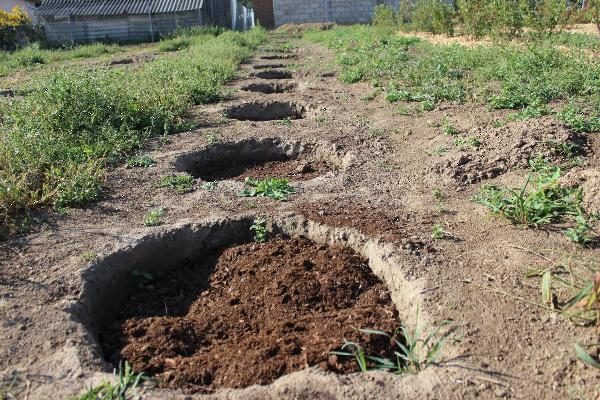
You need to take each component in half a bag of sugar. This amount is enough for one shrub. On light soils, where there is no likelihood of water stagnation, digging a hole deep 55 cm and wide 70-80 cm. On heavy loamy soils, it is necessary to make the pit wider and less deep (30 cm) and the bushes are planted on a small elevation (it is important not to forget to fence and grind after planting).
Landing process
Before you plant blueberries, pots with shrubs should be immersed in a container of water on 3-4 hours in order to earthen clod with roots soaked with moisture.
After soaking the plant must be carefully removed from the pot. Then you need to turn the bush roots up and down cut a ball with the roots crosswise or stretch it with your hands. Blueberry has very thin roots.Americans call them “angel hair”, and in order for them to grow to the sides, the action described above must be performed.
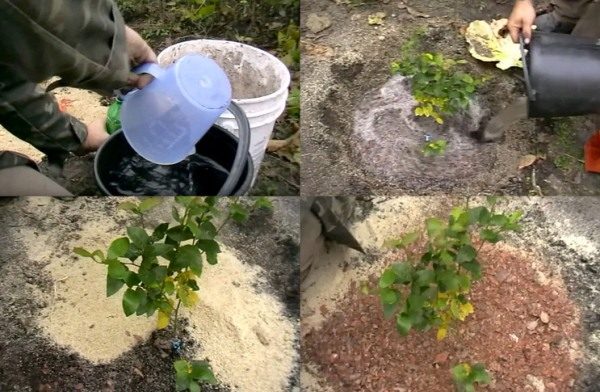
Then the blueberry bush should be immersed in the hole prepared before planting, straighten the roots to the sides and cover with the prepared substrate. Around the bush you need to make a hole and water until full saturation with water. Thereafter the hole should be mulched bark, coniferous litter or straw (a layer of 8-10 cm) to reduce the amount of evaporated moisture and to preserve the friability of the substrate. In addition, soil bacteria, processing this mulch, form citric and acetic acids, which are so necessary for blueberries.
Transplanting blueberries to a new place
It is necessary to transplant garden blueberries to the same depthon which she was in the same place, while allowed to lower the plant deeper than the previous level 3-5 centimetersto cover all the roots. It is desirable to dig at the age of two, when the seedling reaches 50 cm in length and will look quite strong. Before digging, remove all green shoots and flower buds.
When transplanting to a new place, you should not immediately fertilize the soil. During the first year, as soon as the first green leaves and shoots appear, you can use a special fertilizer or 2 oz of azaleas. In case of heavy rainfall after 2-3 months you can once again apply the fertilizer in small doses. Fertilizer should be evenly distributed over the soil surface with a radius of 20-30 cm from the plant itself.
Blueberry care
How to feed
Blueberry is recommended to feed, starting with 2 years of life. Introduce top dressings need gradually. Use for this is mineral fertilizer.They contain all the necessary trace elements and nutrients in the required quantity.
Fertilize garden blueberries need every spring. Proper growth and development of shrubs requires regular feeding minerals.
- Nitrogen fertilizers needed to stimulate the growth and formation of the fruit of this shrub. Usually blueberries require about 55 g of this feeding. Along with this, the plant must be fed with magnesium. Feed the shrub with nitrogen fertilizer costs about three times per season. The very first feeding is carried out in the spring, before the buds swell. It will require about half of the total amount of supplementary food for the entire season. The second feeding is done at the end of May. And the third portion of fertilizer is introduced into the soil in June.

- Phosphoric fertilizers necessary to provide the plant with the necessary substances for stability and viability, as well as to improve the yield. For the full nutrition of one shrub of blueberry, it takes about 30 grams of phosphorus. This dressing should be introduced into the soil in 2 stages. The first dressing should be done in April, and the second in early June.
- Potash fertilizers needed to improve the frost resistance of the plant. And also for protection from drought. In addition, this type of feeding protects blueberries from a variety of diseases and pests. About 35 g of potash fertilizers are required per year. It is necessary to feed blueberries with this fertilizer on the same principle as phosphate fertilizers.
Preparing for the winter
This garden plant tolerates the cold season. But still there is a risk of frostbite of the bushes during very severe frosts. To avoid such unpleasant consequences, you can prepare blueberries for the winter in advance. What is the preparation?
Too much nitrogen can cause lack of ripening of young shoots.. This is due to the fact that the shoots remain too dense and the entire bush may not survive the winter period.
How to care for blueberries in the autumn? In the autumn it is necessary to provide blueberries with moisture. The soil must be saturated with moisture on 35 cm in depth. For bushes that are 3 or 4 years old, you need about 5 buckets of water.
Blueberry feels comfortable when cold to -7 degrees.
When and how to trim the bushes
The fruits of blueberry develop on the growth of the past year. That is why the blueberry bushes should be trimmed only in early spring, before the buds. You should not do this fall, as there is a chance to cut high-quality, good branches with fruit buds. In this case, the harvest for the next year will not be.
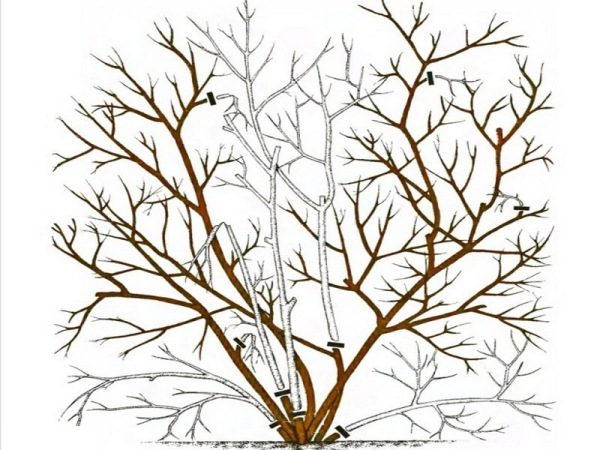
Pruning the tall blueberry bushes is an important point in the process of caring for the plant. The process of cutting the bushes should begin when the plant reaches three years of age.. This is necessary in order to form a strong skeleton of the berry. It should be cut only small increments, which are located at the base of the plant, as well as branches affected by any disease.
Blueberry Trimming Plan:
- only need to cut branches growing close to the ground and save upright branches;
- if in the middle of a bush the branches are too thick, one should find among them weak and old growths and prune them;
- Almost all small increments need to be cut, leaving the largest, dense skeletal branches and strong shoots.
Watering rules
The soil needs to be watered so that not only the soil around the blueberry was wet, but also a lump of soil in which the blueberry grew in a pot (even if it had been actively stirred before) was soaked with water. Otherwise, this clod of earth, densely entwined with its roots, will stand dry in the landing pit. The soil near the bush will be wet, and blueberries will suffer from its lack. Therefore, it is very important to often observe blueberries until it is noticed that it has begun to actively grow shoots (the summer increase of 50-70 cm indicates that the blueberry has taken root).
To grow this shrub in the country, it is desirable to use drip irrigation.
Blueberry is a fairly unpretentious plant and does not require any special care. Some rules of planting, watering and caring for this shrub should be observed., in order to finally get a large number of high-quality crops.
